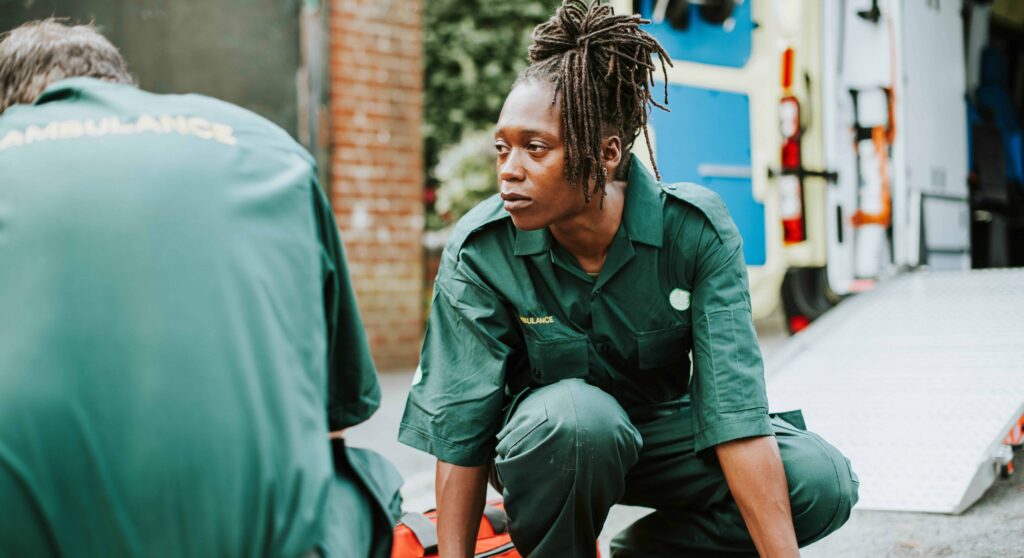First responders are at high risk for developing PTSD because they face traumatic events in accordance with their occupations on an almost daily basis. Firefighters, EMTs, ambulance personnel, and police officers deal with tragic situations that trigger their fight or flight response. In addition, they often need to make life and death decisions during their work. However, first responder PTSD symptoms may not appear immediately. When a person faces a variety of continual trauma situations, subtle changes can occur before the thought of PTSD comes to mind.
How Likely is PTSD in First Responders?
According to SAMHSA (Substance Abuse and Mental Health Services Administration), 1 in 5 people in the general population experience PTSD. Roughly 1 in 3 first responders develop PTSD because 80% of first responders experience traumatic situations. Stigma, unfortunately, exists within the first responder community in regards to reaching out for help for PTSD. Thus, family members and friends often notice first responder PTSD symptoms in their loved ones.
Studies have proven that the following first responders develop PTSD:
- 15% of paramedics
- 13% of rescue teams
- 7.3% of firefighters
- 4.7% of police officers
Stigma can be the reason many first responders do not reach out for help when experiencing the symptoms of PTSD. Watching fellow responders’ behavioral changes can help to determine whether someone is suffering. Education is also an important factor in recognizing symptoms of PTSD.
How is PTSD diagnosed?
First responders, like Veterans, are trained to be tough and find it difficult to admit they are experiencing something different. Therefore, assessments by an experienced mental health professional can evaluate the symptoms being experienced. A medical doctor may also participate in the evaluation to determine if physical symptoms are caused by an illness or injury first. Furthermore, first responder PTSD symptoms can be a combination of mental and physical manifestations.
According to the National Institute on Mental Health (NIMH), a diagnosis of PTSD means the following symptoms occur for at least one month:
- Re-experience of the trauma
- Avoidance behavior
- Arousal/reactivity symptoms
- Cognition/mood symptoms
Re-experience symptoms can include:
- Flashbacks
- Bad dreams
- Frightening thoughts
First Responder PTSD Symptoms
First responder PTSD symptoms you should know can include some warning signs. Changed behaviors that affect relationships at home and even with other first responders need to be addressed, for instance. Hyper-arousal is a common sign, being edgy or fidgety can be an indication. Flying off the handle without reason, and extreme reactions to normal conversations can also be initial warning signs. In addition, avoidance behaviors are common. Intrusive thoughts or bad dreams about certain traumatic events are clues that something is negatively affecting the first responder.
The following are hyper arousal behaviors:
- Irritability and agitation
- Angry outbursts
- Insomnia or change in sleeping habits
- Difficulty concentrating and focusing
Other first responder PTSD symptoms could include the following:
- Feelings of guilt and worthlessness
- Feeling unable to express feelings about a traumatic event
- Loss of interest in usual activities
- Isolation from loved ones and friends
- Sleep disturbances including bad dreams
- Intrusive memories or flashbacks that interfere with daily living
- Feeling paranoid
- Unusually risky or dangerous behaviors
- Self-medication with alcohol or drugs
First responder PTSD symptoms can stem from previous life trauma or pain escalated by the extreme situations in the line of work they are in. Triggers are often factors in PTSD that can occur when facing additional traumas and difficult emotions. Education concerning the symptoms of PTSD needs to be part of the training for these lines of work. Veterans are also highly at risk for developing PTSD, especially those who have experienced combat.
How is PTSD Treated for First Responders?
With first responder PTSD symptoms documented, an assessment and evaluation can determine the diagnosis. Treatment includes cognitive-behavioral therapy (CBT), other types of talk therapy, EMDR, and group therapy. Encouragement from family and friends with an understanding of the mental illness can also be extremely helpful for treatment. In addition, first responder support groups exist for fellow workers who can understand, empathize, and share experiences to help relieve feelings of guilt and shame.
Other treatments can include:
- Exposure therapy: The goal of this therapy is to face and control the fear of the event. Consequently, this includes gradual exposure to the trauma in a safe situation. Imaging, writing, or visiting the place where the event took place helps to cope with feelings.
- Cognitive restructuring: Learning to think about the traumatic event differently by making sense of the bad memory. Guilt and shame often leave first responders blaming themselves. Therefore, learning to look at trauma in realistic ways can ease the pain.
Why First Responders Need PTSD Support Groups
Fear over losing their job, judgments from other co-workers, and stigma are often factors in why first responders do not seek help. For this reason, group therapy for first responders is especially supportive knowing others have the same symptoms from PTSD. Being surrounded by those who can identify with first responder work is important. Family therapy and individual therapy need to be part of the treatment plan. First responder PTSD symptoms can be shared and talked about with other first responders who can understand at a deeper level.
Help for First Responder PTSD Symptoms
Sunrise Veterans Health is here to help you with your first responder PTSD symptoms. Take the next step and reach out for help to heal from the symptoms and deal with PTSD. This is an important step in moving on with your life and getting back to enjoying your first responder position. Work towards having peace in your life with your friends and family by reaching out to our admissions office today.


